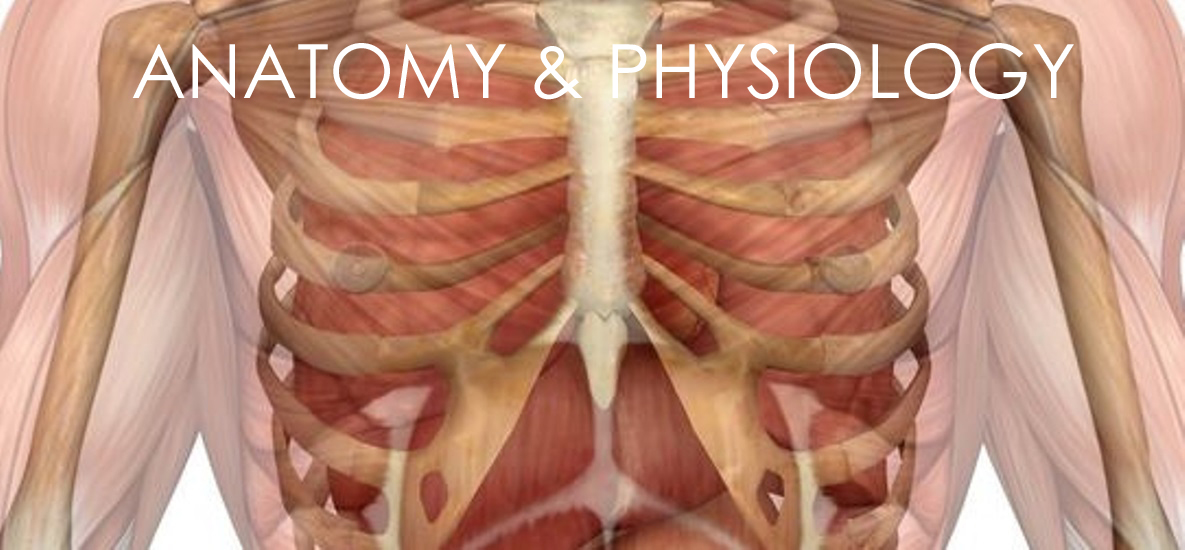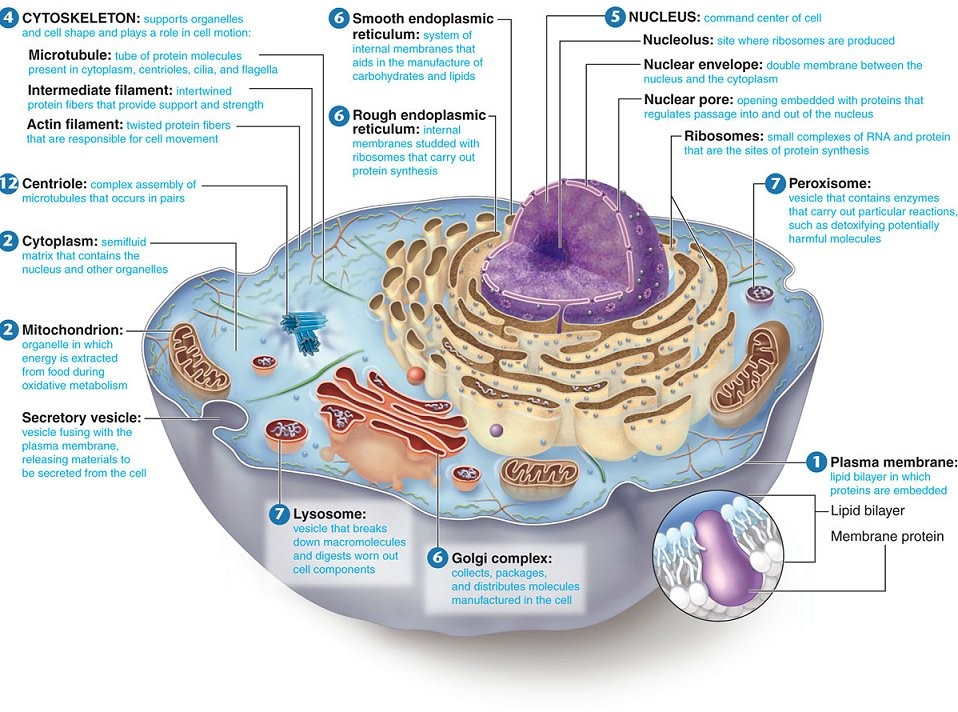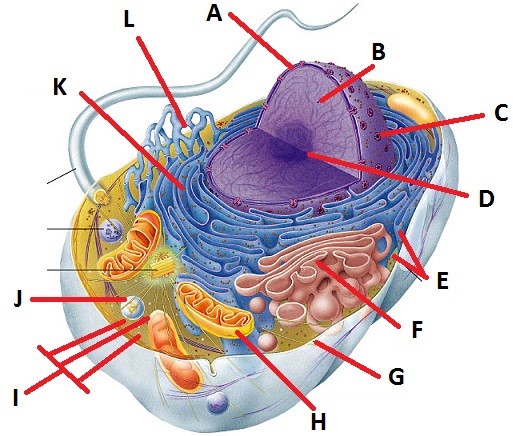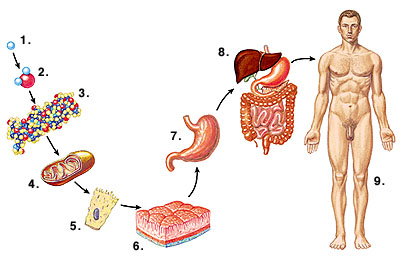My Power Notes Review
Part I
- Define Anatomy: __________________________________
- Define Physiology: _______________________________
- Define Pathology: ________________________________
- Define Pathophysiology: ___________________________
- Define Biology: ___________________________________
- Define Cytology: __________________________________
- Define Histology: _________________________________
- Define Embryology: ________________________________
- Define Microscopic Anatomy: _______________________________
- What type of Cells are we made of: __________________ i.e. Eukaryotic, Prokaryotic?
Part II
a. List of Cell Organelles—Structure at a Glance
b. List of Functions of Cell Organelles-Function at a Glance
Many courses in introductory biology include cell biology and require knowledge of the basic functions of the organelles found in eukaryotic cells. It is useful to be able to summarize the main functions of each type of organelle in just a few words or sentences.
The following table of functions of cell organelles is a list of short summary information for each organelle.
Membrane-bound Organelles
|
||||||||||||||||||||||||||||||||||||||||||||||||||||||||
| Notes:
(1) The numbers on the left are just for ease of reference to this table. Different types cells contain different quantities of the various cellular organelles. (2) *Advanced terms. Understanding this level of detail is not needed for many introductory courses e.g. A-Level Biology. |
||||||||||||||||||||||||||||||||||||||||||||||||||||||||
Non-Membranous-bound Organelles
|
|||||||||||||||||||||||||||||||||
| Note: The numbers on the left are just for ease of reference to this table. Different types cells contain different quantities of the various cellular organelles. | |||||||||||||||||||||||||||||||||
The cell membrane is often included in sections about the structure and functions of cell organelles. However, the cell membrane (also known as the plasma membrane) is not within the cell but one of the structures that defines the cell – together with the cell wall in the cases of plant cells and prokaryotic cells. See functions of the cell membrane.
The above list of functions of organelles shows that many, though not all, membrane-bound organelles are sites of biochemical reactions, i.e. where chemicals are made (= “produced”, “synthesized” or “biosynthesized”) or broken-down (= “degraded’) or changed in some way. Such chemical reactions are examples of metabolic processes and often form part of metabolic pathways. This is way knowledge of cell biology is useful when studying metabolism.
Part III Levels of Organization of Life
Levels of organization of life
- non-living components of life
- atom
- molecule
- within cells
- macromolecule (biological)
- organelles
- within multicellular organisms
- tissue
- organ
- organ systems
- among organisms
- species
- population
- community
- ecosystem
- biosphere
- ecosphere
- represent a hierarchy
- each level incorporates lower levels of organization
Structure of the Cell
Introduction to the cell
- Before microscopes (first used in 17th century), no one knew living organisms were composed of cells
All cells share fundamental features
- Major features common to all cells
- plasma membrane
- encloses cell
- separates contents from surroundings
- phospholipid bilayer
- 5-10 nanometers thick
- contains embedded proteins
- DNA – the hereditary molecule
- prokaryotes
- nucleoid
- area near center of cell, contains circular molecule of DNA
- not differentiated from rest of cell’s contents by membrane
- eukaryotes
- nucleus
- double-membrane bound organelle contains DNA
- cytoplasm
- semi-fluid matrix
- contains chemicals of cell
- sugars
- amino acids
- proteins
- contains organelles in eukaryotes
- carry out metabolism
- interconversion of different forms of energy and of chemical materials
- two major metabolic processes
- photosynthesis
- cellular respiration
- primary tenants of Cell Theory
- all organisms composed of 1 or 1+cells
- cell is smallest (basic) unit of life
- smallest living thing
- cells arise only by division of a previously existing cell
- all life on earth represents continuous line of descent from early cells
Introduction to the cell
- Two kinds of structurally different cells have evolved over time
- prokaryotic cells
- Archaebacteria
- Eubacteria
- eukaryotic cells
- Protista
- Fungi
- Plantae
- Animalia
- Prokaryotic cell characteristics
- small (1/10th size of eukaryote)
- lacks a nucleus
- DNA in nucleoid region (not membrane bound)
- plasma membrane
- bacterial cell wall
- some have pili (sticky)
- some propelled by flagellum
- Eukaryotic cells
- from Greek eu for “true” and karyon for kernal or “nucleus”
- fundamentally similar to each other
- profoundly different from prokaryoes
- characteristics of eukaryotic cells
- in general
- comparing animal and plant cell
- presence vs. absence of cell walls
- animal cells lack cell walls
- some protists lack cell walls
- plants, fungi and some protists have cell walls
- complex interior organization
- extensive compartmentalization
- many membrane-bound organelles
- true, membrane-bound nucleus
- complex DNA molecule
- contain vesicles and vacuoles which function in storage and transport
- membranes partition cytoplasm into compartments called membranous organelles
- location of many chemical activities known as cellular metabolism
- Eukaryotic cells, animal vs. plant
- animal cells
- cell wall absent
- chloroplasts absent
- central vacuole absent
- mitochondria present
- centrioles present
- lysosome present
- flagella may be present
- plant cells
- cell wall present
- chloroplasts present
- mitochondria present
- central vacuole present
- flagella absent (except in some sperm)
- lysosome absent
- centrioles absent
- membranous organelles
- nucleus
- endoplasmic reticulum
- Golgi apparatus
- mitochondria
- lysosome
- peroxisome
- chloroplast
- central vacuole
- non-membranous structures
- centriole
- flagellum
- ribosome
- microtubule
- microfilament
- cell wall
Energy converting organelles
- Chloroplasts
- photosynthesizing organelles of plants and protists
- internal membranes create 3 compartments
- space between inner & outer membranes
- intermembrane space
- space enclosed by inner membrane
- contains
- fluid called stroma
- network of tubules and hollow disks
- space inside tubules and disks
- disks occur in stacks, called grana
- grana are chloroplasts’ solar power packs
- Mitochondria
- energy converting organelles of heterotrophs
- carryout cellular respiration
- chemical energy of foods
- converted to chemical energy of a molecule such as ATP (adenosine triphosphate)
- ATP is main energy source for cellular work
- enclosed by 2 membranes, has 2 compartments
- space between inner & outer membrane
- intermembrane space
- fluid filled compartment
- space enclosed by inner membrane
- contains fluid called mitochondrial matrix
- space enclosed by inner membrane
- contains mitochondrial matrix
- many of chemical reactions of cellular respiration occur here
- inner membrane has many folds
- called cristae
- increases surface area
- contains enzymes that make ATP
Fueling the activities of life
- two main mechanisms by which organisms obtain food
- autotrophs (self-sustaining)
- heterotrophs (not self-sustaining)
Fueling the activities of life
- two main mechanisms by which organisms obtain food
- autotrophs (self-sustaining)
- plants and other photosynthetic organisms
- can produce from inorganic compounds the organic molecules they need for life
- heterotrophs (not self-sustaining)
- animals
- must obtain organic molecules they need by consuming organic molecules already produced by other organisms
How organisms harvest energy from food molecules
- Two major processes enable organisms to fuel the processes of life
- hetertrophs
- ingest their food
- cellular respiration harvests energy from ingested food molecules
- autotrophs
- manufacture their own food via photosynthesis
- cellular respiration harvests energy manufactured food molecules
Cellular Respiration
Introduction to Cellular Respiration
- Respiration
- refers to exchange of gases
- organism obtains O2 from its environment & releases CO2
- Cellular respiration
- aerobic harvesting of energy from food molecules by cells
- Breathing and cellular respiration are related
- organism takes in O2 from environment
- distributes O2 to its cells
- mitochondria use O2 in cellular respiration
Fig. 4.8 – Cellular repsiration
Introduction to Cellular Respiration
- Harvesting energy from food molecules
- glucose – used as a representative food molecule
- summary equation for cellular respiration
- C6H12O6 + 6O2 ® 6CO2 + 6H2O + ATPs
- bond energy from reactants is stored in chemical bonds of ATP
- Efficiency of cellular respiration
- glucose contains chemical energy
- each ATP molecule made by cellular respiration contains ~ 1% of chemical energy in glucose molecule
- cellular respiration is not able to harvest all energy of glucose in a usable form
- typical cell banks ~ 40% of glucose’s energy in ATP molecules
- other ~ 60% is converted to heat
- comparison
- glucose burned in lab
- glucose “burned” in cell
- gasoline engine
- more efficient than any other process a cell can perform without oxygen
- yeast cell in an anaerobic environment harvests only about 2% of energy in glucose
Basic Mechanisms of Energy Release & Storage
- Underlying mechanisms of energy release and harvest in cell
- energy available to cell is contained in chemical bonds of a molecule (glucose)
- cellular respiration dismantles glucose in a series of steps
- taps the energy carried by electrons
- that are rearranged when old bonds break and new bonds form
- cellular respiration shuttles electrons through a series of energy releasing reactions
- electrons start in a molecule where they have more energy & end up in molecule where they have less energy
- energy is released in small amounts
- cell stores some of that energy in ATP
- cells transfer energy from glucose to ATP by coupling exergonic & endergonic reactions
- cellular respiration shuttles electrons through a series of energy releasing reactions
- movement of hydrogen atoms illustrates electron transfers
- glucose loses hydrogen atoms as it is converted to carbon dioxide
- molecular oxygen gains hydrogen atoms as it converted to water
- oxygen serves as the ultimate electron acceptor
Mechanisms of Energy Release & Storage
- Movement of electrons from one molecule to another is oxidation-reduction reaction (redox)
- oxidation
- loss of electrons from one substance (molecule is oxidized)
- reduction
- addition of electrons to another substance (molecule is reduced)
- reactions always go together because electron transfer requires donor and acceptor
- oxidation-reduction reaction (redox)
- glucose gives up energy as it is oxidized
- electrons are moved about by moving hydrogen atoms (along with their electrons)
- electron cascade occurs
- electrons “fall” down an energy “hill” of carriers
- each carrier is different molecule
- electrons move “downhill”
- increasing electron affinity
- redox reactions release energy in small amounts at each step, useful to the cell
- last molecule at bottom of hill is O2
- greatest electron affinity of all carriers
- Electron transport chains
- series of electron carriers
- ordered groups of molecules embedded in membranes of mitochondria
- located in plasma membrane in prokaryotes
- as electrons pass along chain, they lose energy
- which cell can use to make ATP
Stages of Cellular Respiration
- Cellular respiration
- continuous process
- three main stages
- 1st & 2nd stages
- glycolysis
- Krebs cycle
- 3rd stage
- electron transport chain & chemiosmosis
- Glycolysis
- first stage
- occurs outside mitochondria in cytoplasm of
- means “splitting of sugar”
- universal energy-harvesting process of life
- occurs in all cells
- because of its universality, is thought to be ancient metabolic system
- starts with glucose
- Krebs cycle
- 2nd stage
- takes place in mitochondria
- completes breakdown of glucose
- producing carbon dioxide
- contributes electrons to 3rd stage
- produces 2 molecules of ATP
- produces other energy-rich molecules
- Electron transport chain
- 3rd stage
- takes place in mitochondria
- chain uses downhill flow of electrons from electron carriers to oxygen
Photosynthesis: Using Light to Make Food
Photosynthesis uses light energy to make food molecules
- Photosynthesis
- most of living world depends on this process
- on global scale – billions of tons of organic matter are produced each year
- no other chemical process of Earth matches this output
- consists of two stages that occur in chloroplast
Fig. 4.7 – photosynthesis
Autotrophs are the producers of the biosphere
- Plants are autotrophs
- “self-feeders”
- make own food
- sustain themselves
- chloroplasts capture energy in sunlight
- convert sun’s energy to chemical energy using water and carbon dioxide
- stored in form of glucose and other organic molecules
- Producers
- produce food consumed by heterotrophs
- all organisms that use light energy to make food molecules from inorganic molecules
- photosynthetic autotrophs
- producers include
- plants
- certain archaea
- certain bacteria
- certain protists
- Predominant producers
- terrestrial
- plants such as trees
- aquatic
- photosynthetic protists (algae)
- photosynthetic bacteria
Photosynthesis occurs in chloroplasts
- All green parts of a plant have chloroplasts and can carry out photosynthesis
- leaves have most chloroplasts
- are major sites of photosynthesis
- green color in plants – from chlorophyll pigments in chloroplasts
- chloroplhyll absorbs light energy from sun
- Green tissue in interior of leaf is called mesophyll
- each mesophyll cell has numerous chloroplasts
- membranes in chloroplast – many reactions of photosynthesis occur
- inner membrane encloses a compartment filled with a thick fluid called stroma
- within the stroma, disklike membranous sacs called thylakoids are suspended
- thylakoids are concentrated in sacks called grana
Plants produce O2 gas by splitting water
- Photosynthesis equation
- CO2 + H2O ® light® C6 H12 O6 + H2O + O2
Photosynthesis is a redox process, as is cellular respiration
- Photosynthesis is a redox process
- water is oxidized to O2
- when water molecules are split apart
- they lose electrons & hydrogen ions
- CO2 is reduced to sugar
- when electrons & hydrogen ions are added to it
- water is oxidized & carbon dioxide is reduced
- electrons gain energy by being boosted up an energy hill
- converts light energy to chemical energy
- Cellular respiration is a redox process
- sugar is oxidized and oxygen is reduced
- electrons lose energy as they travel down an energy hill
- converts chemical energy from one form to another
Photosynthesis occurs in two stages
- Photosynthesis
- two stages
- light dependent reactions
- first stage
- converts light energy to chemical energy and oxygen gas
- light independent reactions (Calvin cycle)
- second stage
- assembles sugar molecules using CO2 and energy-containing products of the light reactions
- Light dependent reactions
- occur in thylakoid membranes
- absorb solar energy & convert it to chemical energy by
- making ATP from ADP + P
- transferring electrons from H2O to NADP+ to form NADPH
- electron carrier
- no sugar is produced during these reactions
- requires light
- Light independent reactions (Calvin cycle)
- occurs in stroma of chloroplasts
- carries out process of carbon fixation
- incorporation of C from CO2 into organic compounds
- enzymes of cycle then make sugars by further reducing fixed carbon
- by adding high-energy electrons and hydrogen ions to it
- does not require light directly
- but occurs during day in most plants
- light dependent reactions
- occur in thylakoid membrane
- photosystems I & II capture solar energy and energize electrons
- water is split and O2 is released
- photosystems transfer electrons to ETCs
- where energy is harvested and used to make NADPH and ATP
- Light independent reactions (Calvin cycle)
- occurs in stroma
- incorporates carbon from CO2 into sugar G3P
- G3P is used to make sugars which are
- used as fuel for cellular respiration
- used as starting material for other organic molecules such as cellulose
- stored as starch in chloroplasts, roots, tubers, fruits
- photosynthesis
- location: chloroplasts
- equation
- CO2 + H2O ® light® C6 H12 O6 + H2O + O2
- manufactures food molecules
- used by: autotrophs
- cellular respiration
- location: mitochondria (stage 2-3)
- equation
- C6H12O6 + 6O2 ® 6CO2 + 6H2O + ATPs
- harvests energy in food molecules
- used by: autotrophs and heterotrophs
Part IV Common Medical Terms
Common Medical Root Words
The root of a word is its main part and core meaning. These common medical root words give you a general idea of what you’re dealing with or specify a body part.
- Abdomin/o: Abdomen
- Aden/o: Gland
- Anter/o: Front
- Arteri/o: Artery
- Audi/o: Hearing
- Bio: Life
- Brachi/o: Arm
- Bronch/i, bronch/o: Bronchus
- Carcin/o: Cancer
- Cardi/o: Heart
- Col/o: Colon
- Cyt/o: Cell
- Derm/a, derm/o, dermat/o: Skin
- Dors/i, dors/o: Back or posterior
- Encephal/o: Brain
- Gastr/o: Stomach
- Gynec/o: Female
- Hemat/o: Bl ood
- Hist/o, histi/o: Tissue
- Intestin/o: Intestine
- Lapar/o: Abdomen, loin or flank
- Lymph/o: Lymph vessels
- My/o: Muscle
- Neur/o: Nerve
- Ocul/o: Eye
- Ophthalm/o: Eyes
- Optic/o, opt/o: Seeing, sight
- Or/o: Mouth
- Ot/o: Ear
- Path/o: Disease
- Pharmac/o: Drug
- Pulmon/o: Lungs
- Sept/o: Infection
- Thorac/o: Chest/thorax
- Thyr/o: Thyroid gland
- Trachel/o: Neck or necklike
- Trich/o: Hair or hairlike
- Ventr/i, ventr/o: Front of body
- Viscer/o: Viscera (internal organs)
Greek Tidbits in Medical Terms
Most common medical terms used today are derived from Latin or Greek. After all, the Greeks were the founders of modern medicine. Examples of medical terminology used today based on the Greek language are
- The word semantics is derived from the Greek semantikos, meaning “significant.”
- Coccyx comes from the Greek word for “cuckoo” — it resembles a cuckoo’s beak.
- Remember: myo (muscle) is not to be confused with myelo (bone marrow).
- Diaphoresis comes from the Greek dia meaning “through” and phoreo meaning “I carry.” Translated, it means “the carrying through of perspiration.”
- Glaucoma: Greek glaukos means “blue-grey,” and oma means “a condition.” In glaucoma, gray color replaces the black pupil.
- Both Latin and Greek play a role in the roots of the word for heart, cardium. This word stems from the Greek word kardia.
- Adenoid comes from the Greek aden, meaning “gland,” and cidos, meaning “like.” The term was once used for the prostate gland.
- Pancreas is so named because of its fleshy appearance. Greek pan means “all,” and krea means “flesh.”
- Endocrine: Take endo and add it to the Greek krinein, which means “to separate.”
- Paraplegia: The Greek para means “beside,” and plegia means “paralysis.”
- The Greek word pyelos means “tub-shaped vessel,” which describes the shape of the kidney.
- Venereal is derived from Venus, the goddess of love. It was thought in ancient times to be one of the misfortunes of love.
Medical Terms Commonly Misspelled
Don’t get discouraged studying medical terminology. A large group of medical terms are notorious for being difficult to spell. These medical terms are commonly misspelled:
Abscess, adolescence, alimentation, alopecia, Alzheimer, analyze, aneurysm, anorexia, arrhythmia, ascites, asphyxia, asystole, auscultation, callus, catheter, Caucasian, chickenpox, cirrhosis, curettage, decubitus, diabetes mellitus, diaphoresis, diaphragm, dilatation, diphtheria, eczema, effusion, elicit, epididymitis, fascia, flaccid, gallbladder, gangrene, gauge, gonorrhea, hemoptysis, hemorrhoid, humerus, hygiene, icterus, inoculate, intraocular, intussusception, ischemia, melanin, menstruation, oophorectomy, ophthalmology, orthopnea, pacemaker, palliative, palpate, palpitation, perineum, periosteum, peritoneum, peroneal, prosthesis, prostate, protocol, pruritus, rhythm, sagittal, sedentary, sequela, sieve, spleen, splenectomy, supersede, syncope, syphilis, tonsils, tonsillectomy, tricuspid, ventricle, vertical, and xiphoid.
Part V
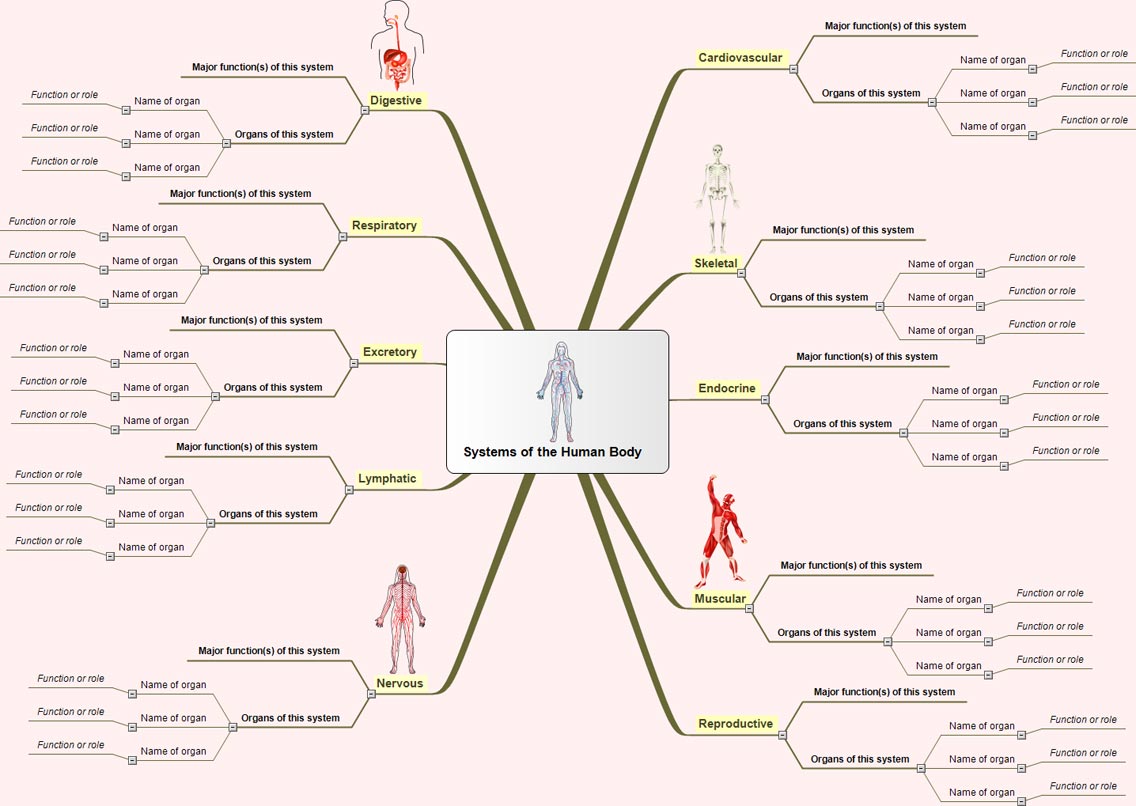

List the Major Body Systems- Their Major Structures and Their Functions
- _________________________ __________________________________________________ ____________________________________________________________________________
- _________________________ __________________________________________________ ____________________________________________________________________________
- _________________________ __________________________________________________ ____________________________________________________________________________
- _________________________ __________________________________________________ ____________________________________________________________________________
- _________________________ __________________________________________________ ____________________________________________________________________________
- _________________________ __________________________________________________ ____________________________________________________________________________
- _________________________ __________________________________________________ ____________________________________________________________________________
- _________________________ __________________________________________________ ____________________________________________________________________________
- _________________________ __________________________________________________ ____________________________________________________________________________
- _________________________ __________________________________________________ ____________________________________________________________________________
- _________________________ __________________________________________________ ____________________________________________________________________________
